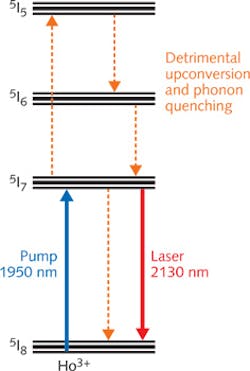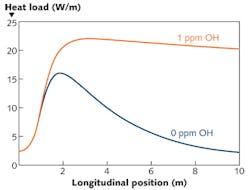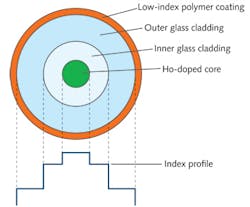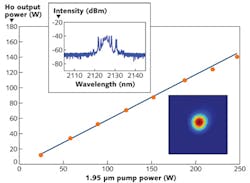OPTICAL FIBER FABRICATION: Holmium-doped silica fiber designs extend fiber lasers beyond 2 µm
Fiber lasers operating at high power levels (greater than 100 W) with high efficiency have historically been limited to devices made from silica fibers doped with ytterbium (Yb; 1 µm operating wavelength), erbium (Er; 1.5 µm), or more recently thulium (Tm; 2 µm). In fact, Tm-doped fiber lasers operating at 2 µm have been demonstrated with as much as 1 kW of singlemode-beam-quality output power from a large-mode-area fiber.1 But more recently, research has focused on holmium (Ho)-doped silica fibers that operate at longer wavelengths (greater than 2.1 µm) than Tm and with higher efficiency when resonantly pumped at 2 µm, offering the potential to scale to higher power levels than the currently available Tm-doped fibers.2
Glass optimization
The design and fabrication of Ho-doped fibers is still largely in the research phase and is being investigated by several groups worldwide.2-4 One of the topics currently under investigation is optimization of the pumping scheme for power scaling to kilowatt levels. The challenges associated with operating this latest family of rare-earth-doped fibers at high power level are numerous and include operating at the long-wavelength transmission limits of silica glass around 2.1 µm, where the multiphonon absorption edge of the silica glass becomes problematic. In addition, the role of extrinsic losses, such as hydroxide (OH) contamination, is also far greater at this operating wavelength.
Optimization of the spectral parameters of Ho-doped silica glass requires mitigation of concentration effects, including up-conversion quenching processes and optimization of co-dopant species in order to minimize clustering and concentration quenching effects on the radiative lifetime (see Fig. 1). The intrinsic nonradiative multiphonon quenching of the holmium 5I7 upper state lifetime is also important and from our measurements is around 0.6 ms at room temperature for fibers doped with 0.5 wt% Ho. This measured lifetime corresponds to a radiative quantum efficiency of approximately 10% for Ho-doped silica. Although much lower than the values associated with Er-doped or Yb-doped silica fibers, this is not a major factor in determining the slope efficiency for high-power lasers and amplifiers.
A major factor in limiting the slope efficiency is the background loss of the fiber and in particular the level of OH contamination from the preform fabrication process. This is particularly important because the overtone of the fundamental OH absorption that occurs around 2.2 µm in silica is relatively close to the lasing wavelength of 2.13 µm in these Ho fibers.5 By resonantly pumping the Ho at 1.95 µm, the goal is to reduce the quantum defect in the fiber laser and hence lower the thermal load on the fiber as compared with 790 nm pumping of Tm-doped fibers. The deleterious effect of small amounts of OH contamination on the thermal load stresses the need for high purity levels in these fibers to increase efficiency and enable high-power laser operation (see Fig. 2).
Novel processes have been developed to minimize OH contamination during the fiber preform manufacturing process. The key is in understanding the various sources of OH contamination and minimizing their impact in a stepwise, controlled fashion. The sources can range from the preform manufacturing process itself, to the purity level of the raw starting chemicals, and to the manner in which the glass is handled during processing. Manufacturers of Ho-doped fibers have developed their own proprietary methods for minimizing OH contamination. These processes include additional drying steps, elimination of the handling of the glass during manufacturing, and strict control of atmospheric conditions. In all cases the additional steps add process time and increase the complexity of manufacturing Ho-doped fibers.
Fiber waveguide design
In addition to glass optimization, fiber waveguide design has also been investigated over the past few years. Early research into Ho-doped fiber lasers typically involved a 1.15 µm pump wavelength and relatively small-core, singlemode fibers. In order to power scale this laser system, many groups have chosen a pump wavelength around 1.95 µm corresponding to direct excitation into the Ho 5I7 metastable level. This pump wavelength is readily available from high-power, singlemode Tm-fiber lasers that now operate at power levels exceeding 100 W and are, in turn, pumped by high-power 790 nm laser diodes.
Modifications of the waveguide design to lower the numerical aperture (NA) of the core with respect to the silica cladding have also been investigated and a range of commercially available singlemode and large-mode-area (LMA) Ho-doped fibers are now starting to emerge. The development of LMA designs for Ho fibers has been far more straightforward than Er:Yb and Tm-doped fibers that both require pedestal fiber designs to obtain a core NA in the range of 0.1. Cladding diameters for the Ho fibers are typically smaller than Yb-doped fibers because of the high brightness of the available Tm-fiber laser pump sources.
One complication of the fiber design is the desire for an inner glass waveguide for the pump light rather than the glass/polymer waveguide often used in Yb-doped fibers. This inner glass waveguide offers a lower loss for the 1.95 µm pump light (see Fig. 3). Despite the use of a fiber laser as the pump source, the overall electrical-to-optical conversion efficiency of this pump scheme is still high due to the high pump conversion efficiency of the Tm-fiber lasers—which is typically 60–65%.
It is worth noting that although double-clad Ho-doped fiber designs operate with lower efficiencies than their triple-clad counterparts, they are often preferred during early stages of device development to more easily optimize the fiber design for the given application. Once the fiber design has been optimized (composition and geometry) in the double-clad version, further optimization into a triple-clad fiber design is relatively straightforward.
Experimental results and future directions
Recently 6, a Ho-doped fiber from Nufern was used to create an efficient 2.13 µm fiber laser source. The Ho-doped fiber was fabricated to be singlemode at 2.1 μm, with a doped core of diameter of 18 μm and 0.08 NA corresponding to a V-number of 2.2. The core was surrounded by a standard octagonal-shaped silica glass inner cladding of 112 μm flat-to-flat diameter. A low-loss 1.95 μm pump waveguide for the inner cladding was achieved using a 180 μm diameter all-glass fluorine-doped outer cladding, providing an NA of 0.22. The fiber was then overclad with silica glass to produce an outer fiber diameter of 250 μm.
The free-space-pumped fiber laser made using this Ho-doped fiber recipe operated at 140 W continuous wave (CW), delivering a singlemode beam at 2.13 µm and a slope efficiency of 60% with respect to the launched pump power (see Fig. 4). A second LMA fiber with 40 µm diameter core was also fabricated and the resultant fiber laser operated at 140 W, pump limited in the same experimental configuration. In addition to CW laser cavities, a gain-switched Ho-doped fiber laser was demonstrated that produced more than 5 W average power at a 600 kHz repetition rate, 85 ns pulse duration (8 μJ) with stable linearly polarized output.
A broad range of applications require laser sources in the 2 μm spectral region including remote sensing, light detection and ranging (lidar), and nonlinear frequency conversion, as well as future high-power laser weapons systems that would all benefit from high-power, mid-IR sources with excellent beam quality.
The atmospheric windows at wavelengths greater than 2.1 µm are of particular interest in military and sensing applications. There are also a variety of scientific, military, and medical applications involving nonlinear frequency conversion into the mid-IR range that often use commercially available zinc germanium phosphide (ZnGeP2) or ZGP crystals. However, defect-related absorption in ZGP below 2.1 μm hinders power scaling due to the associated thermal lensing and degradation of beam quality. This limits the use of Tm-based fiber lasers as pump sources for high power and is an ideal application for a new generation of Ho-doped fiber lasers.
In order to scale CW power and pulse energy, further work is needed to mature the LMA fiber designs as well as the matching support fibers and components required to make monolithic all-fiber devices for robust, compact lasers that could be commercialized. Work by several groups is now focusing on these monolithic devices at high power levels and wavelengths greater than 2.1 µm. It is envisaged that as Ho-doped fiber designs mature, multikilowatt fiber lasers operating beyond 2.1 µm will become readily available.
ACKNOWLEDGMENTS
The authors are grateful to the Defense Science and Technology Office (DSTO) Australia for some of the data used in this article and the US Department of Defense Joint Technology Office for High Energy Lasers (JTO) for funding.
REFERENCES
1. T. Ehrenreich et al., SPIE Photonics West 2010, LASE Fiber Lasers VII: Technology, Systems, and Applications, Conference 7580, Session 16: Late-Breaking News, San Francisco, CA (January 2010).
2. S.R. Bowman et al., SPIE Photonics West 2011, paper 7951-7, San Francisco, CA (January 2011).
3. A. Guhur and S.D. Jackson, Opt. Exp., 18, 19, 20164–20169 (2010).
4. J.W. Kim et al., “Ho-doped silica fibre laser in-band pumped by a Tm-doped fibre laser,” Proc. Lasers and Electro-Optics 2009 and the European Quantum Electronics Conference (CLEO Europe – EQEC), Munich, Germany (2009).
5. R.W. Adams and R.W. Douglas, J. Soc. Glass Tech., 44, 135 (1959).
6. A. Hemming et al., “A 140 W Large Mode Area Double Clad Holmium Fibre Laser,” SPIE Photonics West 2012, Conference 8237, post-deadline paper, San Francisco, CA (January 2012).
About the Author
Bryce Samson
Bryce Samson is vice president of business development at Nufern.
George Oulundsen
George Oulundsen is senior director and general manager at Coherent Corp.
Adrian Carter
Adrian Carter is chief technology officer at Nufern.
Steven R. Bowman
Steven R. Bowman is section head, Advanced Laser Concepts, at the US Naval Research Laboratory.



